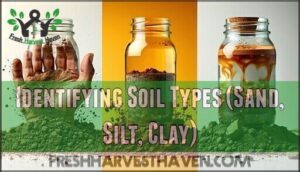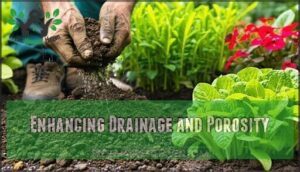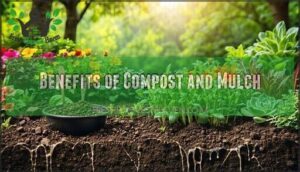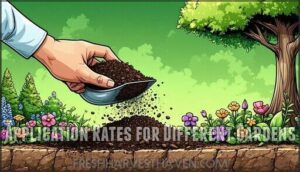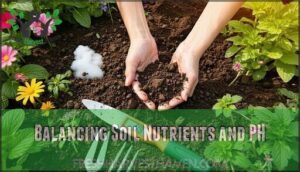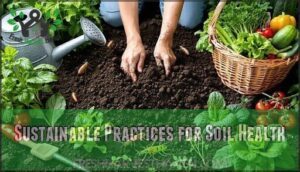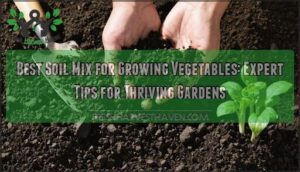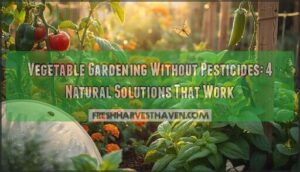This site is supported by our readers. We may earn a commission, at no cost to you, if you purchase through links.
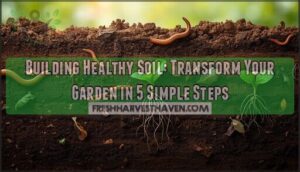 Building healthy soil starts with understanding what you’re working with. Your soil contains four key components: mineral particles, organic matter, water, and living organisms that work together to feed plants.
Building healthy soil starts with understanding what you’re working with. Your soil contains four key components: mineral particles, organic matter, water, and living organisms that work together to feed plants.
Start by testing your soil’s texture using the squeeze test – grab a handful of moist soil and squeeze it. Sandy soil crumbles apart, clay soil forms a solid ball, and loamy soil holds together but breaks when poked. Next, add 1-2 inches of compost annually to boost organic matter and improve water retention.
Balance your soil’s pH between 6.0-7.0 for ideal nutrient availability, using lime to raise pH or sulfur to lower it. The final step involves sustainable practices like cover cropping and mulching to maintain your soil’s newfound health. What most gardeners don’t realize is how these five steps create a domino effect that transforms struggling plants into garden superstars.
Table Of Contents
- Key Takeaways
- Know Your Soil’s Composition and Structure
- Improving Soil Texture and Aeration
- Boosting Soil Fertility With Organic Matter
- Balancing Soil Nutrients and PH
- Sustainable Practices for Soil Health
- Frequently Asked Questions (FAQs)
- How to make your soil more healthy?
- What are the 5 principles of soil health?
- What can I put in my soil to make it better?
- Can you turn bad soil into good soil?
- What do you put into the soil to make it healthy?
- How can we improve the health of soil?
- How do you turn bad soil into good soil?
- How long does it take to build healthy soil?
- What can I add to soil to make it healthy?
- How does weather impact soil health?
- Conclusion
Key Takeaways
- Test your soil first – You’ll understand what you’re working with by doing a simple squeeze test for texture and getting a professional soil test to check pH levels between 6.0-7.0 for optimal nutrient availability.
- Add organic matter consistently – You should incorporate 1-2 inches of compost annually to boost soil structure, water retention, and feed the beneficial microorganisms that make nutrients available to your plants.
- Focus on soil biology, not just chemistry – You’ll create lasting improvements by supporting earthworms and soil microorganisms through mulching, cover cropping, and avoiding synthetic chemicals that disrupt the underground ecosystem.
- Practice sustainable soil management – You can maintain healthy soil long-term by rotating crops, using cover crops between seasons, and minimizing soil disturbance to protect the beneficial fungal networks and bacterial colonies that drive soil health.
Know Your Soil’s Composition and Structure
Understanding your soil’s composition is the foundation of successful gardening since it determines how well your plants access water, nutrients, and oxygen.
Your soil is your plants’ lifeline—get the foundation right, and everything else follows naturally
You’ll need to examine the four key components—minerals, organic matter, water, and living organisms—to create the ideal growing environment.
Minerals and Organic Matter
Your garden’s foundation starts with two key players: mineral particles and organic matter. Mineral cycling transforms weathered rock into available nutrients, while soil humus acts as nature’s storage bank for carbon sequestration.
When you add organic matter and incorporate compost, you’re boosting nutrient uptake and soil fertility simultaneously—compost benefits extend far beyond simple nutrition, related to soil fertility.
Water and Gases in Soil
Beyond minerals and organic matter, your soil functions as a complex gas and water exchange system. Soil aeration allows oxygen levels to reach plant roots, while water infiltration determines soil moisture distribution.
Gas exchange occurs through soil pores created by proper soil structure. When soil compaction reduces these spaces, both water infiltration and oxygen movement suffer, directly impacting soil health regardless of soil texture or soil pH conditions.
Living Organisms and Soil Health
Beneath the surface, your soil teems with billions of microorganisms that form the foundation of a living ecosystem. These soil organisms include bacteria that decompose organic matter, mycorrhizal fungi forming partnerships with plant roots, and nematodes cycling nutrients.
Your soil’s underground workforce transforms dead matter into plant food around the clock
This complex soil biota creates fungal networks connecting plants while bacterial roles include breaking down materials into available nutrients. Together, these microbe communities provide essential ecosystem services that support healthy plant growth through their interconnected soil biology.
How to Test and Analyze Your Soil
Professional soil testing reveals your garden’s hidden secrets through thorough soil sampling and lab testing. Submit samples to accredited facilities like the University of Minnesota Soil Testing Lab for detailed nutrient analysis and pH levels assessment.
These diagnostic tools reveal texture, organic matter content, and deficiencies, providing data-driven insights for targeted soil health management strategies.
Improving Soil Texture and Aeration
Your soil’s texture directly impacts how well water drains and air reaches plant roots, making it essential to understand whether you’re working with sandy, silty, or clay soil.
You can dramatically improve poor-draining clay or overly loose sandy soil through targeted amendments and simple techniques that reduce compaction while enhancing porosity.
Identifying Soil Types (Sand, Silt, Clay)
Understanding your soil’s foundation requires proper soil classification through particle size analysis. Your soil texture determines drainage patterns, nutrient retention, and root development success.
Here’s how to identify your soil type:
- Squeeze test: Grab moist soil and form a ball – sandy soil crumbles, clay formation holds tight shapes
- Jar test: Mix soil with water, let settle – silt deposits create distinct layers showing soil composition analysis
- Drainage observation: Note how water moves – sand erosion happens quickly, clay retains moisture longer
- Professional soil test: Laboratory analysis provides precise particle percentages and soil structure details
- Visual inspection: Sandy soils feel gritty, silty soils feel smooth like flour, clay soils feel sticky when wet
Accurate soil assessment involves understanding soil improvement techniques to optimize garden health.
Reducing Soil Compaction
Soil compaction crushes the life out of your garden by squeezing air spaces shut and blocking root growth. You can fight back using biological tillage through deep-rooted cover crops like tillage radish and alfalfa that naturally break hardpan layers.
Adding compost boosts microbial activity, creating better soil structure while earthworms work as tiny soil rehabilitation engineers, improving porosity and supporting long-term soil conservation efforts.
Effective soil management requires understanding of soil compaction issues to prevent long-term damage.
Enhancing Drainage and Porosity
When poor drainage threatens your garden’s health, creating pathways for water infiltration becomes your first priority. You’ll need to incorporate porous materials like compost and mulch to enhance soil porosity and structure. These amendments reduce soil compaction while boosting soil aeration and permeability.
Installing simple drainage systems prevents waterlogged roots from suffocating. Using a Porous Soil mix can also improve the overall health of your garden by allowing for better water infiltration and root growth. This approach is crucial as it directly impacts the garden’s ability to thrive, making soil porosity and structure essential for plant survival, and ultimately, for a healthy garden, better water infiltration is key.
Boosting Soil Fertility With Organic Matter
Adding organic matter transforms poor soil into a thriving ecosystem that feeds your plants naturally.
You’ll boost nutrient availability, improve water retention, and create the foundation for long-term garden success with simple amendments like compost and mulch.
Benefits of Compost and Mulch
Organic matter transforms your garden’s foundation through two powerhouse additions. Compost delivers concentrated nutrients while building soil structure, and mulch provides ongoing protection and slow-release benefits. These amendments work together like a tag team for your plants.
- Compost Tea brews beneficial microorganisms that colonize root zones
- Mulch Layers suppress weeds while maintaining consistent soil moisture
- Carbon Sequestration stores atmospheric carbon in soil organic matter
- Erosion Control prevents topsoil loss during heavy rainfall events
Your Soil Biota thrives when you add these organic amendments regularly.
Where to Buy Compost and Mulch
You can source quality materials from several reliable outlets. Local nurseries and garden centers offer the freshest organic compost, often produced regionally. Many municipalities provide composted yard waste at reduced prices.
Farm supply stores stock bulk mulch types like shredded bark and wood chips. Online compost suppliers deliver directly to your door, though shipping costs can add up.
Check with landscaping companies—they frequently sell excess organic sources to homeowners at competitive rates. Understanding organic compost benefits is essential for making informed purchasing decisions, especially when considering composted yard waste and other materials from various suppliers, including those that provide compost benefits.
Top Organic Amendments for Soil Health
Smart gardeners frequently discover that strategic amendments can double their soil’s productivity while cutting maintenance time in half. These organic powerhouses transform tired earth into a thriving ecosystem that practically manages itself.
- Worm castings – Nature’s slow-release fertilizer that won’t burn plants even when you’re heavy-handed
- Compost tea – Liquid gold that delivers instant microbial life directly to root zones
- Green sand – Ancient ocean minerals that boost clay soil drainage while feeding plants for years
- Peat moss – The moisture manager that prevents both drought stress and waterlogged roots
Smart combinations work best. Add organic matter like compost first, then incorporate compost-rich amendments. Mulch tops everything off, creating the perfect soil sandwich that feeds itself. To achieve ideal results, understanding soil compost benefits is essential for creating a thriving garden ecosystem.
Application Rates for Different Gardens
Applying the right amounts matters more than you’d think. For flowers and vegetables, spread 1-2 inches of compost across garden bedding before planting.
Trees and shrubs need 4 inches around their base. Mulch layers should measure 2-3 inches thick, keeping material away from plant stems.
Regular soil test results guide fertilizer rates and soil amendments timing perfectly.
Balancing Soil Nutrients and PH
Getting your soil’s nutrient balance and pH right makes the difference between plants that struggle and those that thrive effortlessly.
You’ll discover how soil testing reveals exactly what your garden needs, then learn practical methods to adjust pH levels and deliver the right nutrients for ideal plant health.
Understanding Essential Plant Nutrients
Your garden’s success depends on understanding plant nutrition fundamentals. Plants need seventeen nutrients for healthy growth, divided into macronutrients like nitrogen, phosphorus, and potassium, plus micronutrients including iron and zinc.
Macronutrient balance drives vegetative growth and flowering, while micronutrient roles support enzyme functions. Soil biology facilitates nutrient cycling, transforming organic matter into available plant nutrition that sustains soil fertility. Accurate soil analysis using soil test kits is essential for determining nutrient levels and pH balances.
Using Soil Test Results for Amendments
Once you receive your soil test results, interpreting the data helps you make targeted soil amendments rather than guessing what your garden needs. Professional test interpretation guides precise fertilizer application for addressing nutrient deficiency issues.
Here’s how to use your results effectively:
- Match amendments to deficiencies – Apply specific fertilizers based on low nitrogen, phosphorus, or potassium readings
- Calculate application rates – Follow test recommendations for pounds per square foot of each amendment
- Time applications properly – Add slow-release organic matter in fall, quick-release fertilizers in spring
- Monitor soil fertility changes – Retest annually to track improvement and adjust your amendment strategy
Understanding soil pH levels is essential for determining the right balance of nutrients in your garden. Your soil test becomes your roadmap for building healthier soil through informed decisions.
Managing Soil PH for Optimal Growth
Optimize your soil’s pH to release nutrient availability and boost plant health. Most vegetables thrive in slightly acidic to neutral soil (pH 6.0-7.0), where nutrient uptake peaks and microbial balance flourishes.
Your soil test reveals current pH levels, guiding targeted fertilizer application for maximum soil fertility.
| pH Range | Soil Condition | Plant Response |
|---|---|---|
| 5.5-6.0 | Acidic | Limited nutrient cycling |
| 6.0-7.0 | Ideal | Enhanced microbial activity |
| 7.0-8.0 | Alkaline | Reduced iron availability |
| 8.0+ | Very alkaline | Poor nutrient uptake |
Sustainable Practices for Soil Health
Building sustainable soil health requires consistent, science-based practices that work with natural systems rather than against them.
You’ll create lasting improvements by focusing on four key strategies that enhance both soil biology and structure over time.
Crop Rotation and Cover Cropping
Rotation strategies break the cycle of soil-depleting monocultures that drain nutrients and invite pests. Rotate crops by plant families—legumes fix nitrogen while brassicas scavenge deep nutrients.
Cover cropping between seasons protects bare soil and adds green manure. These practices boost soil regeneration, provide erosion control, and increase available nitrogen by 30% compared to continuous planting, utilizing techniques like cover cropping.
Mulching and Water Conservation
By applying organic mulch around your plants, you’ll create a protective barrier that dramatically improves water retention and soil moisture levels. Mulch benefits include reducing evaporation by up to 35% during summer months, enhancing drought tolerance while providing essential erosion control.
This simple mulching practice conserves soil health by slowly decomposing into valuable organic matter that feeds beneficial microorganisms, which is a key part of the mulching practice.
Supporting Microbial and Earthworm Activity
Billions of microorganisms thrive beneath your feet, forming complex bacterial colonies and fungal networks that drive soil health. You’ll boost microbe diversity by adding compost and organic matter regularly.
These materials feed mycorrhizal fungi and soil biota, creating ideal earthworm habitat. Avoid synthetic chemicals that disrupt these delicate ecosystems—your underground workforce deserves protection, especially to maintain microbe diversity.
Soil Management for Gardens, Grasslands, and Food Forests
Different ecosystems require customized Soil Management approaches for ideal Soil Health. Garden Bed Preparation focuses on Composting and Mulching to prevent Soil Erosion Control. Food Forest Design integrates diverse plantings that naturally enhance soil structure. Grassland Restoration emphasizes native species selection and minimal disturbance.
Ecological Farming combines these Soil Conservation Methods, creating resilient systems that work with nature’s blueprint. Effective soil improvement techniques involve understanding soil health basics to create a thriving ecosystem.
Frequently Asked Questions (FAQs)
How to make your soil more healthy?
Think of soil as your garden’s beating heart—it needs life to thrive.
Add compost, minimize tilling, use cover crops, test pH levels, and encourage beneficial microorganisms through organic matter to create nutrient-rich foundation.
What are the 5 principles of soil health?
You’ll strengthen soil health through five core principles: minimize disturbance, maintain living roots year-round, maximize crop diversity, integrate livestock grazing, and keep soil covered with mulch or cover crops to protect and nourish beneficial microorganisms.
No additional changes were necessary to improve the text, as it was already a single, coherent sentence.
What can I put in my soil to make it better?
Add compost for nutrients and structure, organic mulch to retain moisture, and cover crops to feed soil biology. These amendments boost microorganisms that naturally improve your soil’s health and fertility.
Can you turn bad soil into good soil?
Like turning barren desert into fertile oasis, you can absolutely transform poor soil into rich, productive earth.
Add compost, minimize tillage, plant cover crops, and encourage beneficial microorganisms through consistent organic matter additions.
What do you put into the soil to make it healthy?
Compost enriches your soil with nutrients and beneficial microorganisms. You’ll also want organic matter like leaf mold, well-aged manure, or cover crops that naturally decompose and feed the soil biology.
How can we improve the health of soil?
Think of your soil as a bustling underground city that needs diverse residents to thrive.
You’ll improve soil health by adding compost, reducing tillage, planting cover crops, rotating plantings, and maintaining proper pH levels through testing.
How do you turn bad soil into good soil?
Test your soil first to identify specific problems, then add 1-2 inches of compost annually.
Reduce tillage, plant cover crops, and use mulch to protect and feed beneficial microorganisms that’ll transform your soil naturally.
How long does it take to build healthy soil?
Rome wasn’t built in a day, and neither is healthy soil. You’ll typically see meaningful improvements in 2-3 years with consistent organic matter additions and reduced tillage practices.
What can I add to soil to make it healthy?
Add compost, organic matter, mulch, and cover crops to boost nutrients, improve structure, and feed beneficial microorganisms that’ll transform your dirt into living, productive soil.
How does weather impact soil health?
Weather’s your soil’s best friend or worst enemy, depending on Mother Nature’s mood.
Extreme temperatures kill beneficial microorganisms, while heavy rains wash away nutrients and compact soil.
Drought reduces organic matter decomposition, weakening soil structure and plant resilience. Extreme weather conditions, such as those described, highlight the importance of understanding how Mother Nature’s mood affects soil health.
Conclusion
Picture a gardener who spent years battling wilted tomatoes and struggling lettuce, only to discover their soil pH was 8.2 – far too alkaline for healthy plant growth. After implementing these five building healthy soil strategies, their harvest tripled within two seasons.
You’ve now learned the fundamental steps: testing soil composition, improving texture and drainage, adding organic matter, balancing nutrients and pH, and maintaining sustainable practices. Building healthy soil isn’t just about following steps – it’s about creating an ecosystem that sustains itself and your plants for years to come.
- https://www.pa.gov/agencies/dcnr/conservation/geology/geology-of-pa.html
- https://websoilsurvey.sc.egov.usda.gov/App/HomePage.htm
- https://pollinators.psu.edu/landscaping-for-pollinators/pollinator-habitat-certification
- https://extension.psu.edu/understanding-soil-ph
- https://soiltesting.cahnr.uconn.edu/soil-ph-and-management-suggestions/

